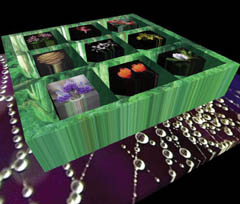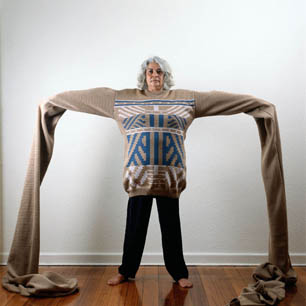Digital indigeneity
Christine Nicholls

Rea, Artificial Garden
In the last issue of RealTime, I wrote about the capacity of the world wide web, digital media and other new technologies to transform the visual arts and artistic practice on a global scale. In particular, I examined a fascinating and timely website (www.mq.edu.au/house_of_aboriginality -expired) that focuses on the question of the appropriation or outright plundering of sacred Indigenous imagery and iconography (mostly for commercial purposes).
A growing number of Indigenous Australian artists are skilled practitioners in new technology. I will be discussing the work of 3 artists who are incorporating digital media into their work in innovative, though contrasting ways.
Rea, Jenny Fraser and Christian Bumbarra Thompson are all at different stages of their careers. Rea is currently completing a Master’s Degree in Science, Digital Imaging and Design at the Centre for Advanced Digital Applications (CADA) at New York University. In undertaking this study she aims to hone her present technical and digital skills and learn new ones to better realise future artistic projects. Writing from her base in New York, she states that she prefers technology-based art forms because of the challenges these present and because she actually conceives her projects in this form.
Rea’s interest in digital media can be traced back to her childhood in the small, predominantly Indigenous community of Coonabarabran, NSW where she was born into the Gamilaroi nation. “My mother first taught me and my siblings about our history by showing us her collection of black and white and sepia photographs that she kept in a biscuit tin covered with red roses. I carried these images in my memories until I went to art school. I then asked my mother if I could have the photos to work with. I began to create coloured photos from my black and white memories so that they would become more real to me. This is where computers came in.
“It was just the right time for me, and my ideas and the first year (1992) that access to digital processes became available to photography majors at the College of Fine Arts, UNSW. Once I realised how much I could do and that the ideas were limitless, [digital processing] became the main focus of creating and exploring new ideas.
“I also felt because it was so new no one could categorise it or me—it gave me the freedom and potential to be an artist, not a lesbian artist, not an Indigenous artist, not even a woman artist, but an artist. So it became the way I allowed myself to explore my medium and the content I was working with as something that was mine with no labels—all mine.
“Now that artists and theorists have begun to create labels and define the process and the medium, there is more of a focus on individual artists and their processes and styles. It was once called ‘digital photography’, then it became ‘digital processes,’ then ‘new media’, then ‘interdisciplinary practice’, now ‘new technologies’ and there will be a million more [labels] until another process comes along and shifts the focus…”
Rea is best known for the equally significant and impressive works Look who’s calling the kettle black (1992) and Don’t shoot till you see the whites of their eyes… (1999), acquired by the Art Gallery of South Australia. The 10 small prints comprising the 1992 work were created to acknowledge the suffering of stolen Indigenous girls forced to work as domestic servants for the colonisers. Rea was inspired by her grandmother to create these, adding a distressing coda: “Many of them never…found their way back home and died in custody. My grandmother was lucky—she found her way home.”
Don’t shoot till you see the whites of their eyes… is a powerful and provoking installation comprising 5 images of gun targets superimposed over the artist, “…5 images of One Pound Jimmy [from an old postcard depicting a traditional Aborigine] with gun scopes on his body and 10 abstract glass heads that sit in front of each work on perspex plinths. The soundscape is of my mother singing hymns and me talking about my personal experiences of dealing with death, especially with dreaming my uncle’s death that happened a week later, the exact same way that I dreamed it—he died in custody.”
While it may be too early to predict the next chapter in Rea’s creative life, she is excited about returning home, applying her new skills and entering a new phase of her life and career. She aims to “…go back to my community and do more workshops and skills sharing so that together we can create work about our culture and community.”
Jenny Fraser, a young artist based in South East Queensland is studying for a Master of Communications at CQU on Indigenous New Media Arts. Her work has been exhibited nationally and internationally and she has won numerous awards. Fraser is the founder of cyberTribe, an Indigenous Online Gallery (www.fineartforum.org/ Gallery/cybertribe.html – no longer live) and was part of the curatorial working group for conVerge—where art and science meet—at the 2002 Adelaide Biennial. Fraser’s works are intelligent and witty, with a wicked sense of humour that belies the seriousness of her approach. For example, her deeply iconic Faster Foods critiques the fast food industry and consumerism, references Australia’s choice of national symbolism and the QANTAS logo, and raises questions about the appropriateness of hoofed animals in Australia and this country’s entrenched eating habits. Because her image taps into so many existing representations of the kangaroo, both literal and metaphorical, it’s possible to read it on many levels, despite its surface simplicity. With Faster Foods Fraser has succeeded—very cleverly—in appropriating the appropriators.
When I asked Jenny Fraser whether she could identify special reasons why Indigenous artists might deploy new media in their artistic practice, or if this was simply a matter of personal preference, her response was “Why not?” (Touché!) New media is attractive because of its “instant” qualities, she writes, and she also enjoys the collaborative nature of working in this currently under-explored terrain.

Christian Bumbarra Thompson, Untitled (Marcia Langton), Blak Palace Series, Tiwi Jumper
Christian Bumburra Thompson is a Melbourne-based photographer, installation artist and curator with a background in sculpture doing a Masters in Fine Art History at Melbourne University (see cover RT#49, also RT#50 p4). Thompson describes his most recent work, Blak Palace, created for the Melbourne Fashion Festival, as his best. “I constructed 3 kitsch jumper designs from the 1980s…the Ayers Rock (Uluru) Jumper, Tiwi Island Jumper and the Kangaroo and Boomerang Jumper. I extended the sleeves to about 4 or 5 metres long and employed 1950s colour. I then took photographs of Indigenous arts workers, academics and curators wearing them. I think it was my most effective work because it combined…elements of performance and sculpture but also was [based on] quite a simple, tangible concept of iconic reclamation.”
Drawn to new media because of the hybrid approaches, forms and technologies with which he can engage, Thompson writes: “I think that it is consistent with our (Indigenous peoples’) artistic philosophies. Whether it is sand sculpture, or traditional cultural painting there has always been that element of experimentation. I can also relate to the ways in which new media can accommodate the performative.”
Like Rea and Jenny Fraser, Christian B Thompson regards his artistic work as inseparable from his political statements. It does not seem a coincidence that all 3 artists are advancing their skills via tertiary courses. New technologies are metamorphosing at such a dizzying rate that it’s incredibly difficult to keep up with new developments in the field.
These 3 cyber-navigators are among the vanguard of a small but growing band of explorer-pioneers in this expanding dominion. The Empire Strikes Back.
RealTime issue #52 Dec-Jan 2002 pg. 20






